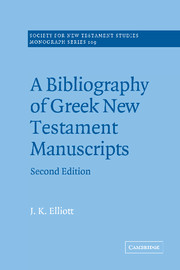Foreword by Bruce M. Metzger
Published online by Cambridge University Press: 29 September 2009
Summary
In the eighteenth century Diderot, the French Encyclopédiste, wrote ‘Je distingue deux moyens de cultiver les sciences: l'un d'augmenter la masse des connaissances par des découvertes; et c'est ainsi qu'on mérite le nom d'inventeur; l'autre de rapprocher les découvertes et de les ordonner entre elles, afin que plus d'hommes soient éclairés, et que chacun participe, selon sa portée, à la lumière de son siècle.’ This book, which belongs to Diderot's second category, supplies a much-needed bibliographical tool.
Compiling bibliographies is like fishing with a net. The size of the catch is determined both by the scope of the net and by the tightness of the mesh. Dr Elliott has cast a wide net with narrow mesh, and, consequently, very little that is of importance has escaped his search.
Of the three categories of source materials used in the textual criticism of the New Testament – Greek manuscripts, early versions, patristic quotations – it is, of course, Greek manuscripts that are of primary importance. Now that the sum total of all such witnesses exceeds five thousand, the student (and even the scholar) is often hard put to it to track down information pertaining to a particular manuscript. Although the compiler of this volume disclaims any intent to be exhaustive (an aim that is tantamount to following a will-o'-the wisp), the following pages will prove to be an invaluable aid for many in their scholarly research. Here one finds the titles of books and articles involving editions, facsimiles, and collations, many of which are found in out-of-the-way publications as well as in unpublished theses and dissertations, set forth under the customary categories of papyri, uncials, cursives, and lectionaries.
- Type
- Chapter
- Information
- A Bibliography of Greek New Testament Manuscripts , pp. ix - xPublisher: Cambridge University PressPrint publication year: 2000

